 I just finished helping my son create a PowerPoint presentation about our trip to Washington, which reminded me that I never finished my travelogue. We spent an extra day in Washington after my conference ended, so I could have one more full day to explore. To save time and avoid blistered feet, we bought Tourmobile tickets so we could ride around to the various attractions. We spent about half the day in Arlington National Cemetery. If you truly want to understand that freedom isn't free, go to Arlington. Symbols of sacrifice surround you: row after row of headstones, monuments to various people and events, and a solemness that one finds in few places these days. Let me take you on a virtual tour...
I just finished helping my son create a PowerPoint presentation about our trip to Washington, which reminded me that I never finished my travelogue. We spent an extra day in Washington after my conference ended, so I could have one more full day to explore. To save time and avoid blistered feet, we bought Tourmobile tickets so we could ride around to the various attractions. We spent about half the day in Arlington National Cemetery. If you truly want to understand that freedom isn't free, go to Arlington. Symbols of sacrifice surround you: row after row of headstones, monuments to various people and events, and a solemness that one finds in few places these days. Let me take you on a virtual tour...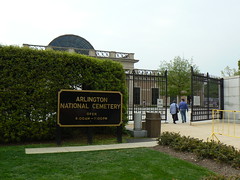
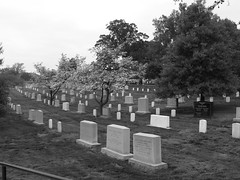
A crowd gathers at the eternal flame, which marks the resting place of JFK and his wife:

Nearby lies the grave of Robert Kennedy:
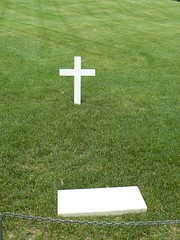
The tomb of the unknowns:
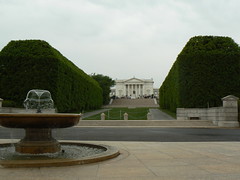
Guard at the tomb of the unknowns:
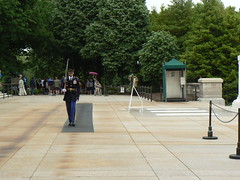
There are marks worn into the stone showing the path the guard follows. The guard changes every half hour in a ceremony that takes about ten minutes. In the photo above, you can see the resting places of the three unknowns, one each from World War I, World War II, and the Korean War. There used to be one from the Vietnam War too, but his remains were identified with DNA testing. His remains were then exhumed and reburied in a cemetery in his home town.
There's a small room below the tomb that's used as the guard quarters. Their creed is posted where you see it as you enter:
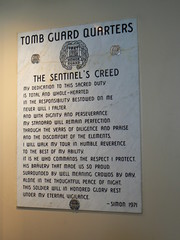
In addition to the Kennedys, many famous people are interred at Arlington. Here are just a few:
Audie Murphy:
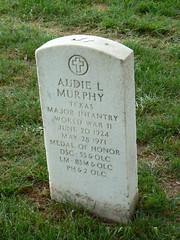
Joe Louis:
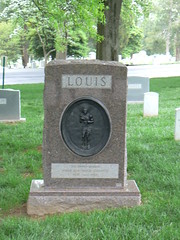
General George C. Marshall:
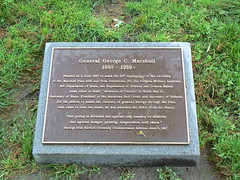
The cemetery includes several memorials, including the sinking of the USS Maine, the Challenger, and of course 9-11.
The land belonged to the family of Robert E. Lee and was forfeited to the US government when Lee didn't return to pay taxes on it. I suppose it would have been a bit awkward for him to return, since he was by then the leader of the Confederacy, and taxes had to be paid in person. The Lee family home remains at Arlington and is open for tours. It includes the main house, a garden, and the slave quarters, plus a museum devoted to Lee.
In addition to Lee, there are many Confederate soldiers buried at Arlington. I find our nation's treatment of the Confederates, especially Lee, interesting. They were traitors by most definitions, taking up arms against their country. Yet Lee was not hanged when he surrendered, nor were his soldiers. Union generals even forbade their troops to celebrate openly when the war ended, lest it look like gloating. The seeds of reconciliation were sown immediately. Somehow I don't see that happening today.
Finally, I'd like to end this post with some eloquent prose about the meaning of Arlington and the feelings it evokes, but even a month's reflection hasn't helped me come up with anything to do it justice. So I'll end, not with my words but with the words of one of the Tourmobile guides. A former military man with the eloquence and cadence of Barack Obama, he spoke of the shared sacrifice of generations of soldiers buried there. Then he made a comment that I didn't expect: Indicating the many memorials to the terrible cost of war, he commented that war is sometimes necessary but should always be the last resort. Amen, brother.



No comments:
Post a Comment